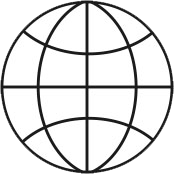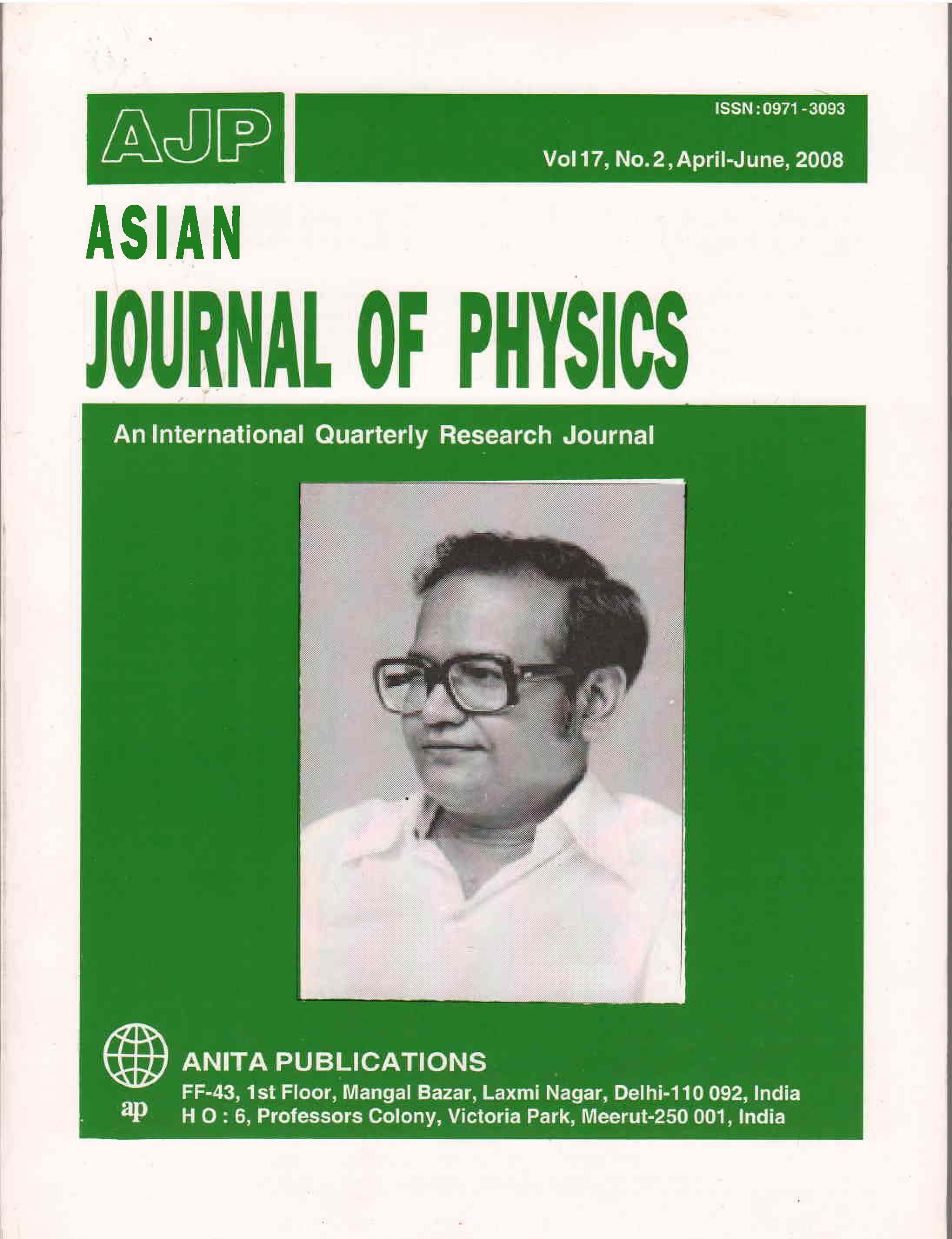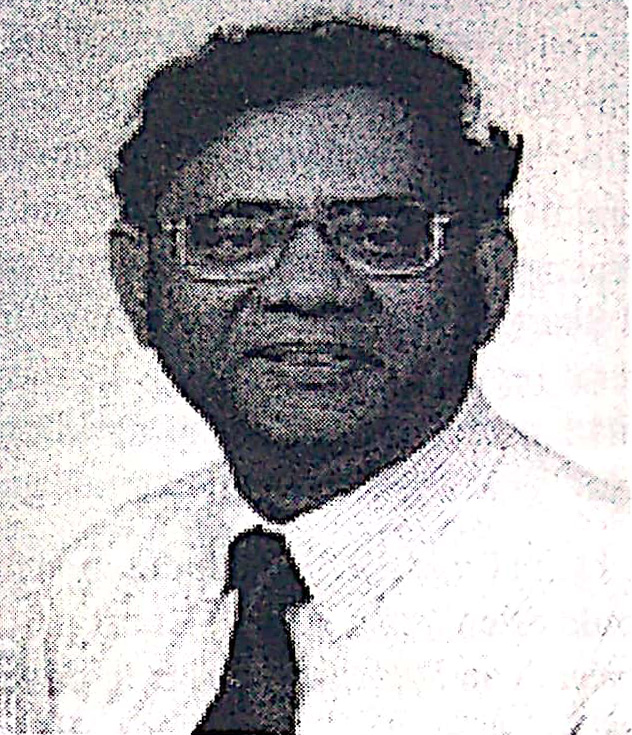
ap

ap
An International Peer Reviewed Research Journal

AJP
ISSN : 0971 - 3093
Vol 17, No. 2, April-June, 2008
ASIAN JOURNAL OF PHYSICS
Vol 17, No. 2, April-June, 2008
CONTENTS
Editorial
About the Guest Editors
Guest Editorial : A professor's bounty: in remembrance of Prof Prasad Khastgir
Pankaj K Choudhuty and Pradip K Jain
Prasad Khastgir, my mentor
Akhlesh Lakhtakia
Professor Prasad Ranjan Khastgir—a Reminiscence
B N Basu
The future of optoelectronics technology
Pankaj K Choudhury and Akhlesh Lakhtakia 181
Morphological influence on surface-wave propagation at the planar interface of a metal film and a columnar thin film
Akhlesh Lakhtakia and John A Polo Jr 185
A survey of the techniques for nondestructive electrical characterization of materials at microwave frequencies
Devendra
K
Mishra
193
Micro mirror based Hadamard transform spectrometer
Sachin Singh, Banmali S Rawat, Moncef B Tayahi, Marian Hanf Steffen Kurth and Thomas Gessner 203
Electrically controlled Bragg resonances of an ambichiral electro-optic structure: oblique incidence
Mukul Dixit and Akhlesh Lakhtakia 213
Novel nanomaterials synthesis by laser-liquid-solid interaction
Jogender Singh 225
An experimental investigation of double-pass erbium-doped optical amplifier with Tunable band-pass filter
Shankar S Pathmanathan, Hairul A abdul-Rashid and Pankaj K Choudhury 241
Cited: 2 times
Modeling and simulation of all-optical intelligent routed networks Under traffic control protocols
V K Chaubey 245
Modeling of the power budget of remotely pumped long haul OFCS incorporated with Pre-EDFA and DRA
Nadir Hossain,V Mishra, A W Naji, M A Hasnayeen and A R Faidz 253
Particle physics with extra dimensions: State- of the-Aart
Md Mijanur Rahman and Pankaj K Choudhury 263
cited: 5 times
Design of low power SRAM cell for write/read operation
Ajay Kumar Singh and CMR Prabhu 273
Simulation of resonant meander-line attenuators for high-power helix traveling-wave tubes
A K Agrawal, S Raina, Rajkumar and Sudhir Kamath 279
OFDM based QOS and capacity enhancement for mobile networks
Chhaya Dalela, P K Dalela and D Chandra 285
Electromagnetic analysis of ohmic quality factor for the tapered gyrotron cavity
Inderjit Singh, Umesh Kumar, Vishal Kesari, P K Jain and B N Basu 289
Radiation characteristics of modified box-horn with metamaterial
Pankaj Sood and S P Singh 297
Microwave response of vegetation lady's finger by bistatic scatterometer
R Prasad, D Singh and K P Singh 303
A simple analysis of backward-wave oscillation criterion for helix traveling-wave tubes
Subrata K Datta, P Sidharthan, P Raja Ramana Rao and S U M Reddy 307
Patch antenna on biased ferrite substrate—Role of orientation of magnetic field in frequency agility
Vijay K Pandey, A Srivastav and B R Vishvakarma 313
Prasad Khastgir, my mentor
Akhlesh Lakhtakia
Department of Engineering Science and Mechanics Pennsylvania State University
University Park, PA 16802, USA
Early during my third year as a B.Tech. (Electronics Engg.) student at the Institute of Technology, Banaras Hindu University, I met Prof Prasad Khastgir. He was my teacher in a course on modern physics. He would walk into the classroom, address the students as "Friends," and begin to ruminate on the topic of the day. His teaching style was very different from those of other professors: neither would he provide copious notes on the blackboard, nor would he make us solve numerous problems in the classroom. Instead, he would ask questions, most of which he would answer himself. He would also invite questions, and would answer them too! In-class examinations seemed to matter little to him. I sensed that not only was he not interested in testing us (and failing some students), but that he wanted each one of us to develop his or her innate capacity to learn. His was a refreshing approach, one that I have adopted during my teaching career at Penn State as well.

One day, shortly after the Durga Puja vacations, Prof Khastgir invited me to visit him at his home that evening. I was flattered: here was a respected professor inviting an undergraduate student to partake refreshments with him, that too at his home. I had never been to a professor's home before. Surely, it must be different from my parents', neither of whom was a professor. What wonderful treasures must exist in a professor's home?
The evening was magical. I remember arriving a few minutes earlier than the planned 6 pm. The door of the house (New G 13, Hyderabad Colony, BHU) was open. I entered a drawing room with a sofa, a divan, a couple of chairs, a cabinet of curios, and two sets of shelves replete with books. Some books were piled on the floor as well. The titles of the books were fascinating. They ranged from physics to philosophy to literary criticism. Most were in English, but I spotted a few in Hindi and Bangla as well. A young child came from another door into the room. I told him that I had come to see Prof Khastgir. He asked me to sit down. "Baba would be along shortly."
Prof Khastgir came out in a few minutes, dressed in the same clothes in which he had taught me earlier in the day. After some pleasantries had been exchanged, he enquired about my hostel accommodations and my family, and then asked me if, while living in Lucknow, I had ever taken any interest in kathak, thumri, and dadra. No I had not, I replied, I knew nothing about Hindustani classical music. So he enquired about my taste in Western classical music. Sadly, I knew nothing about Beethoven, Mozart, and Bach either.
Just about then, before our conversation could pall (I thought), someone else came to the house, and then a third person. Within a few minutes, the drawing room was full of students chattering about music, literature, and even some politics. I was fascinated. So, this is what a salon must be, I thought.
Prof. Khastgir presided at this salon. Actually, "presided" is too authoritarian a word for him. He merely "guided" any conversation that had petered into silence, From time to time, someone would appeal to his authority, and he would provide his view. Mrs Khastgir would send copious amounts of tea to lubricate the conversations. Some savories also were supplied occasionally. But most people were interested mostly in conversations. Around 9 pm, the drawing room emptied.
Well, I became a regular visitor to his salons for the remaining two years and a half of my studentship at IT. Often we would sit in Prof Khastgir's drawing room, sipping cups of tea; but sometimes a few of us would sally forth for a long walk with him under the mango trees. I met students and professors from diverse BHU colleges. We discussed the metaphysical writings of Henri Poincaré and the foibles of the English upper class as described hilariously by P G Wodehouse. Occasionally, someone would bring over a gramophone. I came to love Harry Belafonte, especially Jamaica Farewell ("Down the way where the nights are gay/ And the sun shines daily on the mountain top") and Banana Boat ("Come, Mr Tally Man, tally me banana/ Daylight come and we wanna go home"). I discovered the mellifluous voice of Jagjit Singh, and Amir Meenai's ghazal "Saraktii jaai hai rukh se naqaab aahistaa aahistaa" became my favorite. I became convinced that science, mathematics, and engineering must be accorded the status of liberal arts. I came to appreciate Bimal Mitra and Sharat Chandra Chattopadhyay more than Rabindra Nath Tagore, despite the efforts to the contrary of several regulars at the salons. In short, impressionable as I must then have been, Prof Khastgir's simple invitation one day ended up molding my intellectual consciousness and my ways of interacting with the world. What a great gift my mentor gave me!
I left IT mid-1979 and India soon thereafter. In Salt Lake City, Utah and later in State College, Pennsylvania, I would often think of Prof Khastgir. Communications in those days were not as easy as nowadays. I also had a research and teaching career to develop. My contact with Prof Khastgir dried up.
Then in December 1990,1 visited the Electronics Engineering Department in IT. Prof Khastgir came to attend my seminar. We spent a few minutes together afterwards. He was still his jolly self. Apart from arthritis and sundry other ailments, he informed me that he was very well indeed. Two years later, I was fortunate to spend a week delivering a short course on electromagnetics and optics in the Applied Physics Department. He was then heading that department. Our discussions encompassed the extended boundary condition method, ever.isotropic chirality, Green functions, and much more. I also spent one evening at his salon. It was as vibrant as ever
In December 1995, 1 took my daughter, Natalya to IT for a short visit. Prof Khastgir made a point of regularly enquiring about her progress thereafter. We began to communicate by postal mail several times a year. Once in awhile, I would call him on the telephone from State College. Whenever I visited BHU, I would spend some time with him, until he retired to Chandan Nagar.
I last spoke to him in February 2006, when I was visiting Pradip Jain in the Electronics Engineering Department. Prof Khastgir was in Chandan Nagar then. Although in great pain from his arthritis and suffering from diabetes and a handful of other medical problems, he sounded cheerful. Thus, the news of his demise a few months later was a shock, although I realized that it must have come as a blessing to him.
How can one sum up the impact of a mentor? I can talk about him for hours, as my Wife, Mercedes will testify and then I fall silent because the only conversation that I can then have about Prof Khastgir is with myself. I know that he mentored several generations of IT students, but I still feel that all of his efforts were directed towards shaping me alone.
Asian Journal of Physics Vol. 17, No.2 (2008) 181-183
The future of optoelectronics technology
Pankaj K. Choudhury1 and Akhlesh Lakhtakia2
1Faculty of Engineering, Multimedia University, Cyberjaya 63100, Selangor, Malaysia
2Computational and Theoretical Materials Science
Group, Department of Engineering Science and
Mechanics,
The Pennsylvania State University, University Park, PA 16802,
USA
___________________________________________________________________________________________________________________________________
R&D opportunities in optoelectronics technology exist in the areas of performance improvement, cost reduction, high-volume manufacturing, and integration with other technologies. Developments will be crucial to the expansion of the markets for optical communication, optical data storage, optical imaging, optical computing, and optical sensing systems. © Anita Publications. All rights reserved.
___________________________________________________________________________________________________________________
Asian Journal of Physics Vol. 17, No.2 (2008) 185-191
Morphological influence on surface—wave propagation at the
planar interface
of a metal film and a columnar-thin
film
Akhlesh Lakhtakia1 and John A. Polo, Jr.2
1Department of Engineering Science & Mechanics,
Pennsylvania State University, University Park, PA 16802, USA.
2Department of Physics and Technology,
Edinboro University of Pennyslvania,Edinboro, PA 16444, USA
___________________________________________________________________________________________________________________________________
The
selection of a higher vapor deposition angle when growing a
columnar thin film (CTF) leads to surface-wave propagation at a
planar metal-CTF interface with phase velocity of lower magnitude
and shorter propagation range. Acordingly, a higher angle of
plane-wave incidence is required to excite that surface wave in a
modified Kretschmann configuration. © Anita Publications. All
rights reserved
____________________________________________________________________________________________________________________________________
Asian Journal of Physics Vol. 17, No.2 (2008) 253-262
Modeling of the power budget of remotely pumped long haul OFCS
incorporated with Pre-EDFA and DRA
Nadir Hossain,V Mishra, A W Naji, M A Hasnayeen and A R Faidz
Faculty of Engineering, Multimedia university, 63 100 Cyberjaya, Se langon Malaysia
___________________________________________________________________________________________________________________________________
This
paper focuses on the modeling of the power budget of remotely
pumped long haul optical fiber communication system (OFCS)
incorporated with an Erbium doped fiber amplifier in the pre-length
(Pre-EDFA) and distributed Raman amplifier (DRA). Signal loss in
the post- and pre-length as well as signal gain by the Pre-EDFA and
DRA are simulated to determine the maximum achievable transmission
distance of a remotely pumped long haul OFCS incorporated with
pre-EDFA and DRA. Design parameters of pre-EDFA are optimized using
the numerical simulation of EDFA rate equation model in order to
optimize the pre-EDFA. DRA mathematical model is solved numerically
to analyze the signal propagation characteristics through the
pre-length due to DRA. The results obtained frorn the numerical
simulation of EDFA and DRA mathematical model are used in the
modeling of the power budget of remotely pumped long haul OFCS
incorporated with pre-EDFA and DRA. The developed model can be used
to design and analyze the performance of a long haul OFCS link and
to optimize the system performance. ©Anita Publications. All rights
reserved.
___________________________________________________________________________________________________________________________________
© ANITA PUBLICATIONS
All rights reserved
Designed & Maintained by
Manoj
Kumar